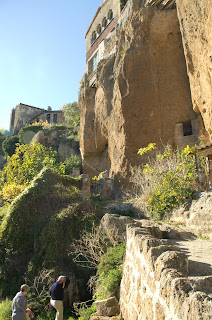Civita is the ultimate hill town. That may sound like a
cliché, but it’s hard to think about this small town any other way. With a
permanent population of seven, yes, seven, the town is known in Italian "asil paese che muore" (the town that is dying).
It’s not only dying in terms of population, it is literally falling apart as
the cliffs erode and fall into the Tiber River valley below.
In the past it was
connected to the larger Bagnoregio by a saddle that filled the canyon between
Civita and its then-small suburb. Over time the saddle eroded away and was
replaced by a walking bridge that is now the connection between the two towns.
There is also a trail up from the valley floor, but that is not a realistic
alternative for most. Deliveries are made by motorbike instead of donkeys
today. We also saw an ambulance parked by the entrance to the bridge and
watched one lady being driven to that ambulance on a golf-cart sized truck.
Later we saw it back in Civita waiting for the next person overcome by the
climb and the heat.
We chose a beautiful sunny
Sunday afternoon make our visit. It seems that everyone else in the area had
the same idea. Instead of being able to park under the bridge connecting the
two towns, we were forced to use a parking lot 2 kilometers away which also
meant more up and down climbing. We finally reached the bridge after enjoying
the views of Civita in the distance. After paying our €1.5 for a ticket to the
town, we started on the bridge. The first half of the walk is quite pleasant.
Then it gets steep for the last 300 meters. We were ready for a break once we
finished the climb into town, but it seemed that every restaurant and bar was
full.
We started our exploration with the Church of St. Donato. This church had been the cathedral until 1699 as the town had already begun its decline accelerated by a major earthquake four years earlier. One benefit of the earthquake was that it revealed a beautiful fresco, the Madonna of the Earthquake, when the whitewash covering it fell off. Whitewashing frescoes had become the thing to do during the baroque era as the churches brightened the interiors. For us in the United States, this is reminiscent of the modernization of buildings that took place in the 1950s and 1960s as the beautiful ceilings and other adornments were covered to look more modern. It has only been in the last couple of years that the beautiful interior of Seattle’s King Street train station has been restored as the dropped ceiling was removed and the entire interior restored to its former glory.
The church also houses a
wooden crucifix carved in the 15th century by the school of
Donatello. The remarkably expressive face seems to change appearance as you
move from side to side. The eyes also seem to follow you as you move.
Upon leaving the church
and its square, we walked the rest of the way to the end of town passing
several more full restaurants and bars. At the end of town and down the hill we
were greeted by the Garden of Poets with its great views of the surrounding
countryside.
 |
| Landslides are a constant problem here |
A bit further down the
trail I passed several shallow caves cut into the side of the hill including a
Chapel of the Incarcerated with its Madonna and Child painted on the tiles. It
was used as a prison prior to the 1695 earthquake. A few feet further on is a
tunnel that was cut through the hillside to facilitate farmers who needed to
get to their separated fields. It is now closed.
 |
| Chapel carved into the side of the cliff |
 |
| Eventually this trail leads to the valley below. Today it is only used by intrepid hikers. |
After trying at a couple
of places for a table, we finally found a small place that served bruschetta
and lasagna along with steaks and platters of cured meats and cheeses. The
lasagna was baked in a toaster oven. Everything else was cooked over the coals
of an open fire by the entrance to the caves that housed the restaurant and the
old olive and wine presses open for viewing by the tourists.
 |
| Eating among the relics |
Our last stop was the
Antica Civita, a museum where we viewed more old presses including one turned
by donkey, tools, and the home of a mill worker who lived in this cave until
the 1930s. We also saw some old pictures including one of the saddle that used
to span between the two villages.
 |
| Entrance to the cave |
 |
| Olive press |
 |
| Filters for the olive oil |
 |
| Another olive press with a drain to collect the oil |
 |
| A humble abode |

















No comments:
Post a Comment